Research Proposal: Health Insurance, TPA, and UAE Population Health
VerifiedAdded on 2020/05/16
|24
|5886
|210
Report
AI Summary
This research proposal investigates the complex relationship between health insurance, Third Party Administrators (TPAs), and the health status of the population in the United Arab Emirates (UAE), specifically focusing on Dubai and Abu Dhabi. The study aims to explore the problems faced by UAE residents when utilizing health insurance benefits, while also highlighting potential health advantages and disadvantages associated with these insurance schemes. The research employs a positivist philosophy with a deductive approach and a descriptive research design, utilizing stratified sampling and qualitative analysis methods to analyze interview responses. The proposal outlines the rationale for the research, which stems from the increasing healthcare costs and the introduction of mandatory health insurance in the UAE. The study also aims to identify the awareness of UAE employees regarding the role of TPAs in health insurance, assess the health benefits enjoyed by the population, and uncover any health threats or complications related to the policies. The literature review covers the health system reform in the UAE, particularly in Abu Dhabi and Dubai, examining the different insurance schemes and the role of TPAs in health coverage. The research questions address the awareness of TPA's role, the benefits experienced, and any health-related complications. The methodology includes details on sampling, data collection methods, a time plan, and ethical considerations. The research seeks to provide recommendations to improve the understanding of health insurance schemes and the role of TPAs, ultimately promoting optimal healthcare access for the UAE population.
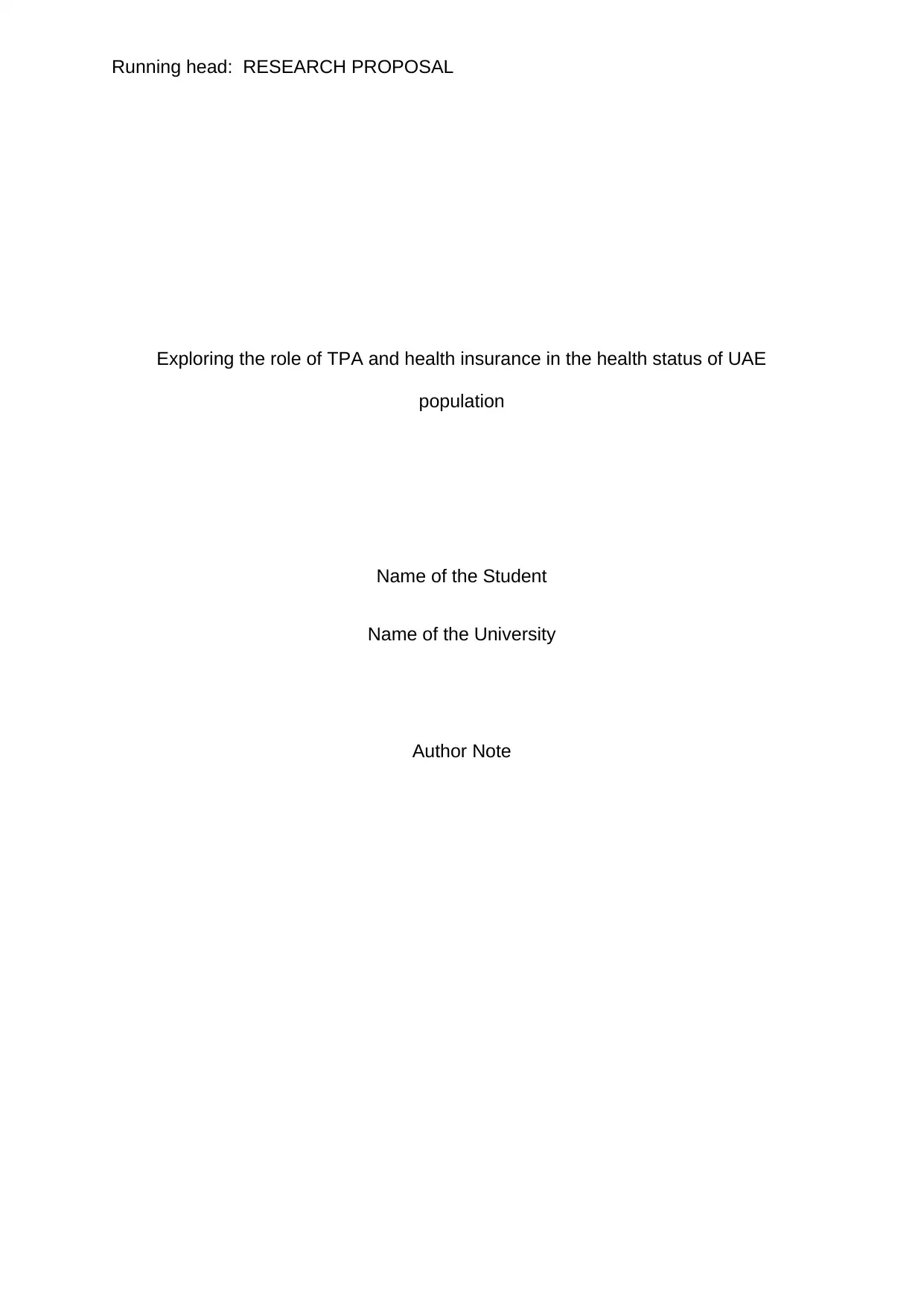
Running head: RESEARCH PROPOSAL
Exploring the role of TPA and health insurance in the health status of UAE
population
Name of the Student
Name of the University
Author Note
Exploring the role of TPA and health insurance in the health status of UAE
population
Name of the Student
Name of the University
Author Note
Paraphrase This Document
Need a fresh take? Get an instant paraphrase of this document with our AI Paraphraser
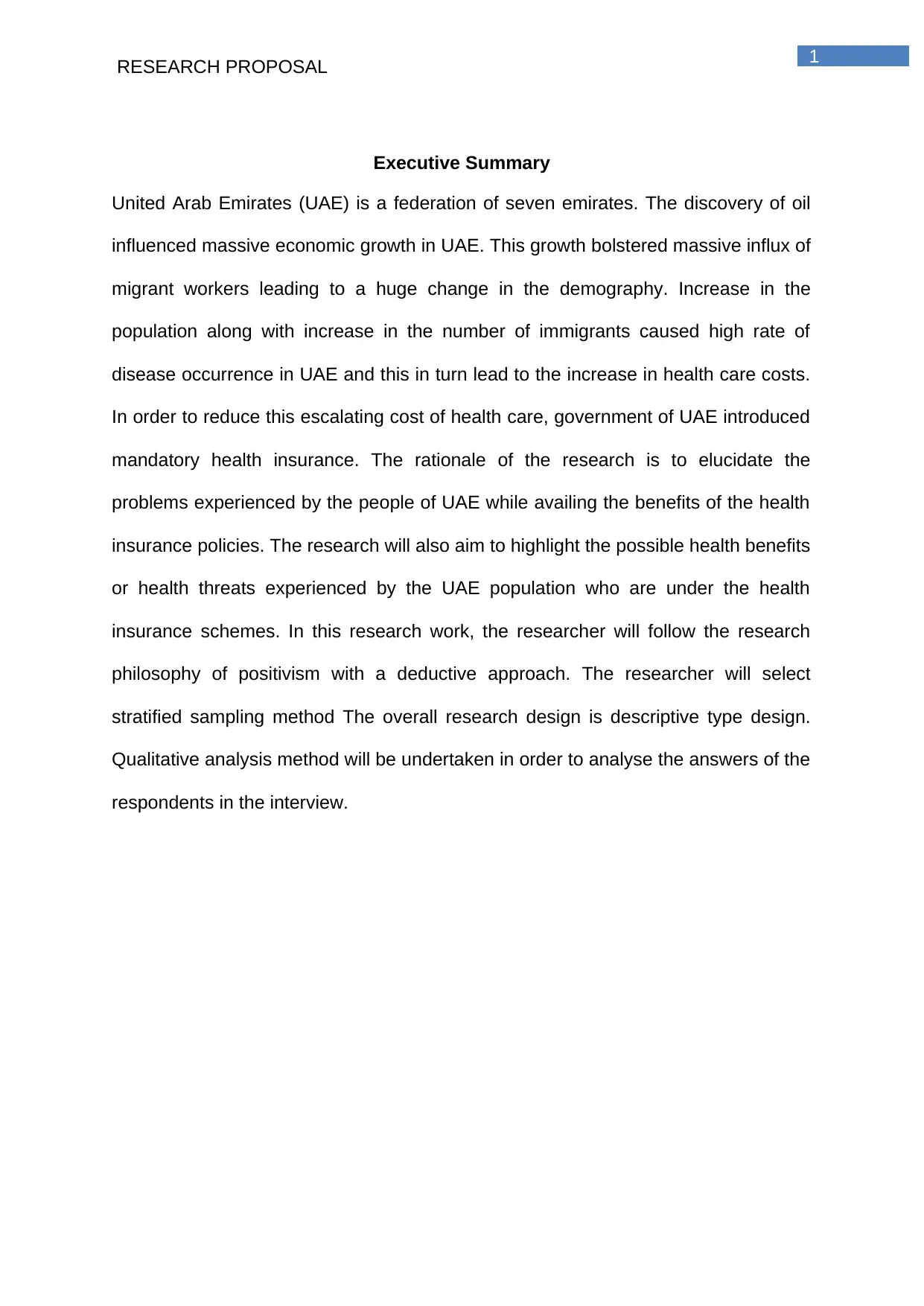
1
RESEARCH PROPOSAL
Executive Summary
United Arab Emirates (UAE) is a federation of seven emirates. The discovery of oil
influenced massive economic growth in UAE. This growth bolstered massive influx of
migrant workers leading to a huge change in the demography. Increase in the
population along with increase in the number of immigrants caused high rate of
disease occurrence in UAE and this in turn lead to the increase in health care costs.
In order to reduce this escalating cost of health care, government of UAE introduced
mandatory health insurance. The rationale of the research is to elucidate the
problems experienced by the people of UAE while availing the benefits of the health
insurance policies. The research will also aim to highlight the possible health benefits
or health threats experienced by the UAE population who are under the health
insurance schemes. In this research work, the researcher will follow the research
philosophy of positivism with a deductive approach. The researcher will select
stratified sampling method The overall research design is descriptive type design.
Qualitative analysis method will be undertaken in order to analyse the answers of the
respondents in the interview.
RESEARCH PROPOSAL
Executive Summary
United Arab Emirates (UAE) is a federation of seven emirates. The discovery of oil
influenced massive economic growth in UAE. This growth bolstered massive influx of
migrant workers leading to a huge change in the demography. Increase in the
population along with increase in the number of immigrants caused high rate of
disease occurrence in UAE and this in turn lead to the increase in health care costs.
In order to reduce this escalating cost of health care, government of UAE introduced
mandatory health insurance. The rationale of the research is to elucidate the
problems experienced by the people of UAE while availing the benefits of the health
insurance policies. The research will also aim to highlight the possible health benefits
or health threats experienced by the UAE population who are under the health
insurance schemes. In this research work, the researcher will follow the research
philosophy of positivism with a deductive approach. The researcher will select
stratified sampling method The overall research design is descriptive type design.
Qualitative analysis method will be undertaken in order to analyse the answers of the
respondents in the interview.
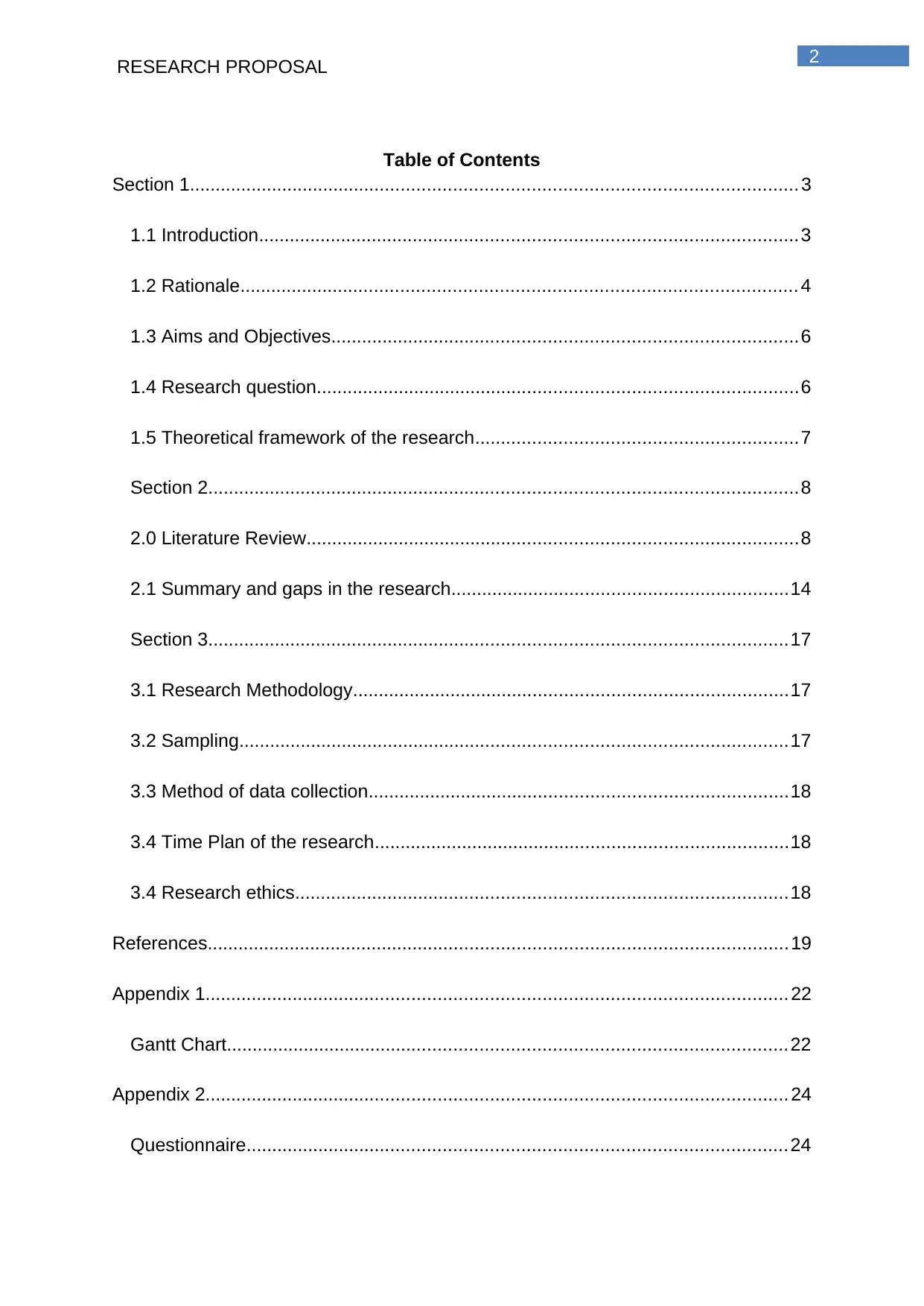
2
RESEARCH PROPOSAL
Table of Contents
Section 1..................................................................................................................... 3
1.1 Introduction........................................................................................................3
1.2 Rationale........................................................................................................... 4
1.3 Aims and Objectives..........................................................................................6
1.4 Research question.............................................................................................6
1.5 Theoretical framework of the research..............................................................7
Section 2..................................................................................................................8
2.0 Literature Review...............................................................................................8
2.1 Summary and gaps in the research.................................................................14
Section 3................................................................................................................17
3.1 Research Methodology....................................................................................17
3.2 Sampling..........................................................................................................17
3.3 Method of data collection.................................................................................18
3.4 Time Plan of the research................................................................................18
3.4 Research ethics...............................................................................................18
References................................................................................................................19
Appendix 1................................................................................................................ 22
Gantt Chart............................................................................................................22
Appendix 2................................................................................................................ 24
Questionnaire........................................................................................................24
RESEARCH PROPOSAL
Table of Contents
Section 1..................................................................................................................... 3
1.1 Introduction........................................................................................................3
1.2 Rationale........................................................................................................... 4
1.3 Aims and Objectives..........................................................................................6
1.4 Research question.............................................................................................6
1.5 Theoretical framework of the research..............................................................7
Section 2..................................................................................................................8
2.0 Literature Review...............................................................................................8
2.1 Summary and gaps in the research.................................................................14
Section 3................................................................................................................17
3.1 Research Methodology....................................................................................17
3.2 Sampling..........................................................................................................17
3.3 Method of data collection.................................................................................18
3.4 Time Plan of the research................................................................................18
3.4 Research ethics...............................................................................................18
References................................................................................................................19
Appendix 1................................................................................................................ 22
Gantt Chart............................................................................................................22
Appendix 2................................................................................................................ 24
Questionnaire........................................................................................................24
⊘ This is a preview!⊘
Do you want full access?
Subscribe today to unlock all pages.

Trusted by 1+ million students worldwide
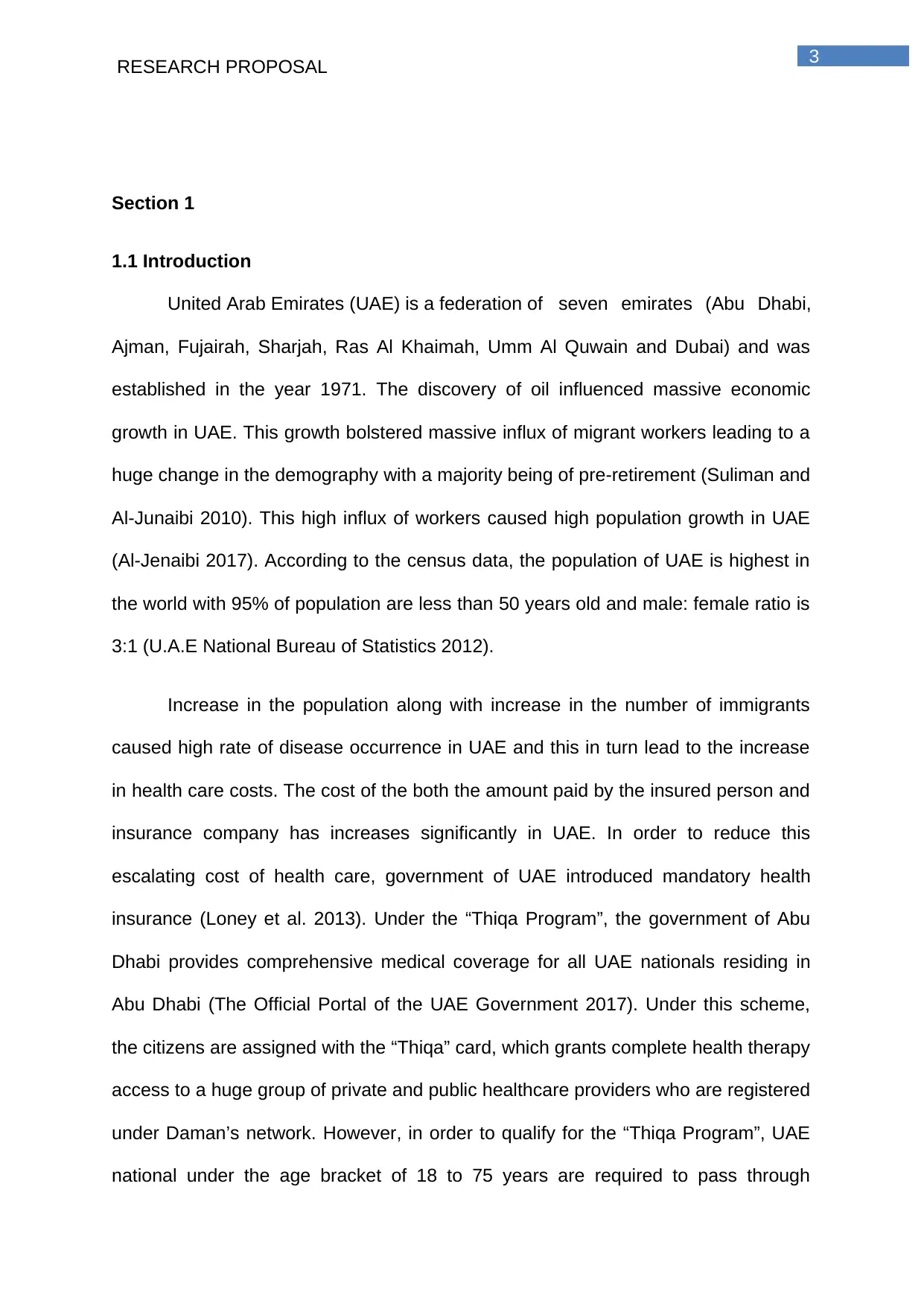
3
RESEARCH PROPOSAL
Section 1
1.1 Introduction
United Arab Emirates (UAE) is a federation of seven emirates (Abu Dhabi,
Ajman, Fujairah, Sharjah, Ras Al Khaimah, Umm Al Quwain and Dubai) and was
established in the year 1971. The discovery of oil influenced massive economic
growth in UAE. This growth bolstered massive influx of migrant workers leading to a
huge change in the demography with a majority being of pre-retirement (Suliman and
Al-Junaibi 2010). This high influx of workers caused high population growth in UAE
(Al-Jenaibi 2017). According to the census data, the population of UAE is highest in
the world with 95% of population are less than 50 years old and male: female ratio is
3:1 (U.A.E National Bureau of Statistics 2012).
Increase in the population along with increase in the number of immigrants
caused high rate of disease occurrence in UAE and this in turn lead to the increase
in health care costs. The cost of the both the amount paid by the insured person and
insurance company has increases significantly in UAE. In order to reduce this
escalating cost of health care, government of UAE introduced mandatory health
insurance (Loney et al. 2013). Under the “Thiqa Program”, the government of Abu
Dhabi provides comprehensive medical coverage for all UAE nationals residing in
Abu Dhabi (The Official Portal of the UAE Government 2017). Under this scheme,
the citizens are assigned with the “Thiqa” card, which grants complete health therapy
access to a huge group of private and public healthcare providers who are registered
under Daman’s network. However, in order to qualify for the “Thiqa Program”, UAE
national under the age bracket of 18 to 75 years are required to pass through
RESEARCH PROPOSAL
Section 1
1.1 Introduction
United Arab Emirates (UAE) is a federation of seven emirates (Abu Dhabi,
Ajman, Fujairah, Sharjah, Ras Al Khaimah, Umm Al Quwain and Dubai) and was
established in the year 1971. The discovery of oil influenced massive economic
growth in UAE. This growth bolstered massive influx of migrant workers leading to a
huge change in the demography with a majority being of pre-retirement (Suliman and
Al-Junaibi 2010). This high influx of workers caused high population growth in UAE
(Al-Jenaibi 2017). According to the census data, the population of UAE is highest in
the world with 95% of population are less than 50 years old and male: female ratio is
3:1 (U.A.E National Bureau of Statistics 2012).
Increase in the population along with increase in the number of immigrants
caused high rate of disease occurrence in UAE and this in turn lead to the increase
in health care costs. The cost of the both the amount paid by the insured person and
insurance company has increases significantly in UAE. In order to reduce this
escalating cost of health care, government of UAE introduced mandatory health
insurance (Loney et al. 2013). Under the “Thiqa Program”, the government of Abu
Dhabi provides comprehensive medical coverage for all UAE nationals residing in
Abu Dhabi (The Official Portal of the UAE Government 2017). Under this scheme,
the citizens are assigned with the “Thiqa” card, which grants complete health therapy
access to a huge group of private and public healthcare providers who are registered
under Daman’s network. However, in order to qualify for the “Thiqa Program”, UAE
national under the age bracket of 18 to 75 years are required to pass through
Paraphrase This Document
Need a fresh take? Get an instant paraphrase of this document with our AI Paraphraser
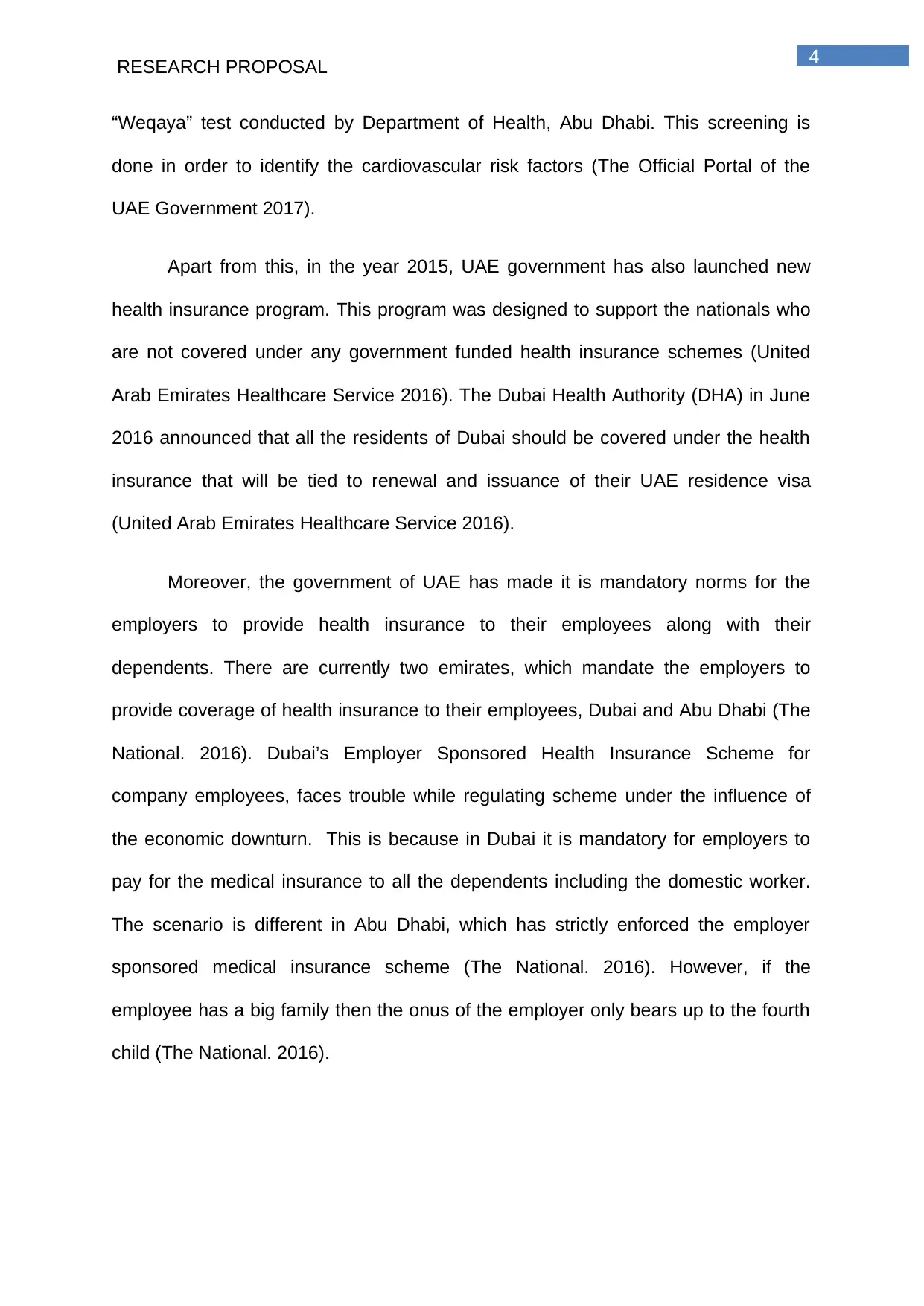
4
RESEARCH PROPOSAL
“Weqaya” test conducted by Department of Health, Abu Dhabi. This screening is
done in order to identify the cardiovascular risk factors (The Official Portal of the
UAE Government 2017).
Apart from this, in the year 2015, UAE government has also launched new
health insurance program. This program was designed to support the nationals who
are not covered under any government funded health insurance schemes (United
Arab Emirates Healthcare Service 2016). The Dubai Health Authority (DHA) in June
2016 announced that all the residents of Dubai should be covered under the health
insurance that will be tied to renewal and issuance of their UAE residence visa
(United Arab Emirates Healthcare Service 2016).
Moreover, the government of UAE has made it is mandatory norms for the
employers to provide health insurance to their employees along with their
dependents. There are currently two emirates, which mandate the employers to
provide coverage of health insurance to their employees, Dubai and Abu Dhabi (The
National. 2016). Dubai’s Employer Sponsored Health Insurance Scheme for
company employees, faces trouble while regulating scheme under the influence of
the economic downturn. This is because in Dubai it is mandatory for employers to
pay for the medical insurance to all the dependents including the domestic worker.
The scenario is different in Abu Dhabi, which has strictly enforced the employer
sponsored medical insurance scheme (The National. 2016). However, if the
employee has a big family then the onus of the employer only bears up to the fourth
child (The National. 2016).
RESEARCH PROPOSAL
“Weqaya” test conducted by Department of Health, Abu Dhabi. This screening is
done in order to identify the cardiovascular risk factors (The Official Portal of the
UAE Government 2017).
Apart from this, in the year 2015, UAE government has also launched new
health insurance program. This program was designed to support the nationals who
are not covered under any government funded health insurance schemes (United
Arab Emirates Healthcare Service 2016). The Dubai Health Authority (DHA) in June
2016 announced that all the residents of Dubai should be covered under the health
insurance that will be tied to renewal and issuance of their UAE residence visa
(United Arab Emirates Healthcare Service 2016).
Moreover, the government of UAE has made it is mandatory norms for the
employers to provide health insurance to their employees along with their
dependents. There are currently two emirates, which mandate the employers to
provide coverage of health insurance to their employees, Dubai and Abu Dhabi (The
National. 2016). Dubai’s Employer Sponsored Health Insurance Scheme for
company employees, faces trouble while regulating scheme under the influence of
the economic downturn. This is because in Dubai it is mandatory for employers to
pay for the medical insurance to all the dependents including the domestic worker.
The scenario is different in Abu Dhabi, which has strictly enforced the employer
sponsored medical insurance scheme (The National. 2016). However, if the
employee has a big family then the onus of the employer only bears up to the fourth
child (The National. 2016).
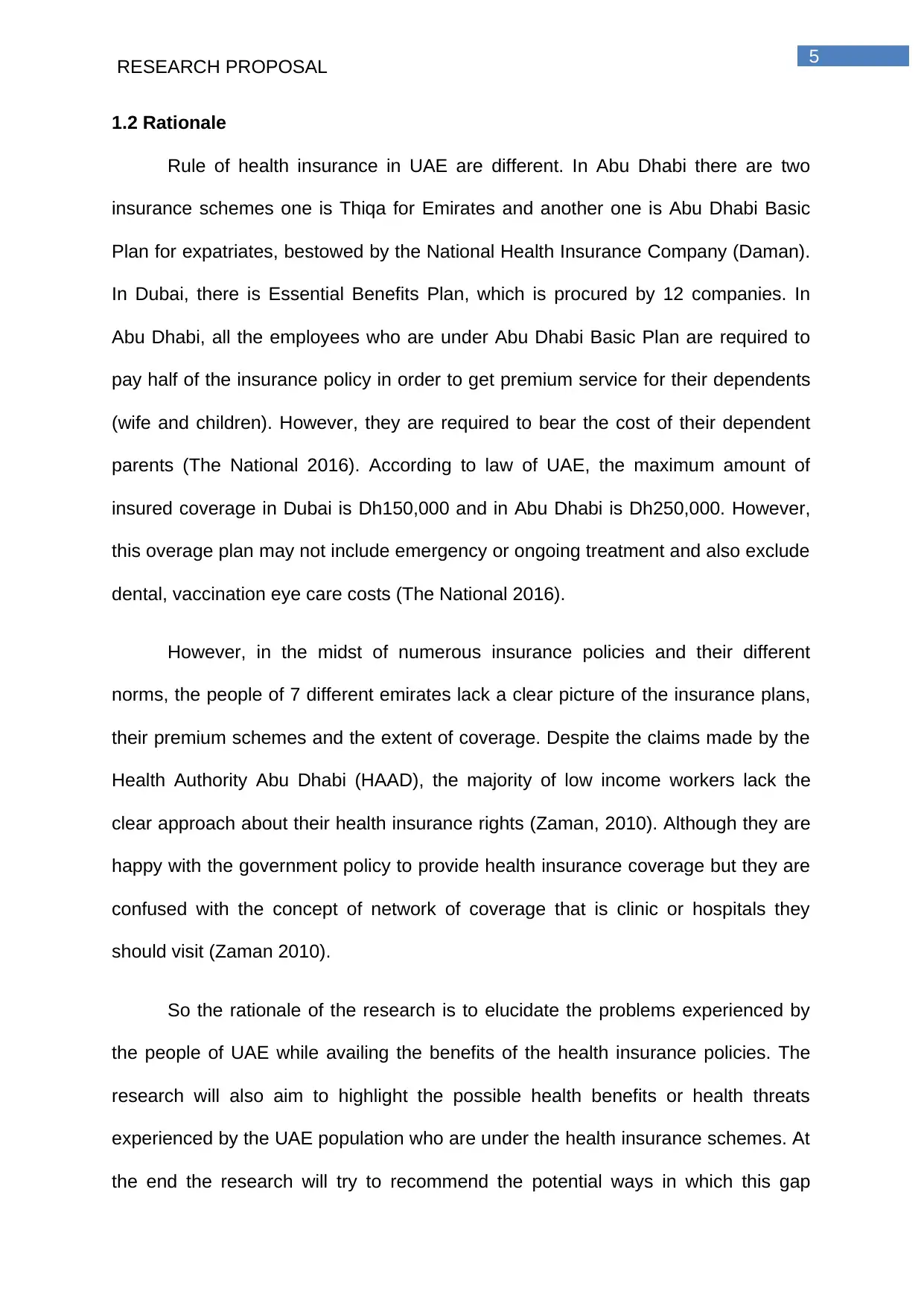
5
RESEARCH PROPOSAL
1.2 Rationale
Rule of health insurance in UAE are different. In Abu Dhabi there are two
insurance schemes one is Thiqa for Emirates and another one is Abu Dhabi Basic
Plan for expatriates, bestowed by the National Health Insurance Company (Daman).
In Dubai, there is Essential Benefits Plan, which is procured by 12 companies. In
Abu Dhabi, all the employees who are under Abu Dhabi Basic Plan are required to
pay half of the insurance policy in order to get premium service for their dependents
(wife and children). However, they are required to bear the cost of their dependent
parents (The National 2016). According to law of UAE, the maximum amount of
insured coverage in Dubai is Dh150,000 and in Abu Dhabi is Dh250,000. However,
this overage plan may not include emergency or ongoing treatment and also exclude
dental, vaccination eye care costs (The National 2016).
However, in the midst of numerous insurance policies and their different
norms, the people of 7 different emirates lack a clear picture of the insurance plans,
their premium schemes and the extent of coverage. Despite the claims made by the
Health Authority Abu Dhabi (HAAD), the majority of low income workers lack the
clear approach about their health insurance rights (Zaman, 2010). Although they are
happy with the government policy to provide health insurance coverage but they are
confused with the concept of network of coverage that is clinic or hospitals they
should visit (Zaman 2010).
So the rationale of the research is to elucidate the problems experienced by
the people of UAE while availing the benefits of the health insurance policies. The
research will also aim to highlight the possible health benefits or health threats
experienced by the UAE population who are under the health insurance schemes. At
the end the research will try to recommend the potential ways in which this gap
RESEARCH PROPOSAL
1.2 Rationale
Rule of health insurance in UAE are different. In Abu Dhabi there are two
insurance schemes one is Thiqa for Emirates and another one is Abu Dhabi Basic
Plan for expatriates, bestowed by the National Health Insurance Company (Daman).
In Dubai, there is Essential Benefits Plan, which is procured by 12 companies. In
Abu Dhabi, all the employees who are under Abu Dhabi Basic Plan are required to
pay half of the insurance policy in order to get premium service for their dependents
(wife and children). However, they are required to bear the cost of their dependent
parents (The National 2016). According to law of UAE, the maximum amount of
insured coverage in Dubai is Dh150,000 and in Abu Dhabi is Dh250,000. However,
this overage plan may not include emergency or ongoing treatment and also exclude
dental, vaccination eye care costs (The National 2016).
However, in the midst of numerous insurance policies and their different
norms, the people of 7 different emirates lack a clear picture of the insurance plans,
their premium schemes and the extent of coverage. Despite the claims made by the
Health Authority Abu Dhabi (HAAD), the majority of low income workers lack the
clear approach about their health insurance rights (Zaman, 2010). Although they are
happy with the government policy to provide health insurance coverage but they are
confused with the concept of network of coverage that is clinic or hospitals they
should visit (Zaman 2010).
So the rationale of the research is to elucidate the problems experienced by
the people of UAE while availing the benefits of the health insurance policies. The
research will also aim to highlight the possible health benefits or health threats
experienced by the UAE population who are under the health insurance schemes. At
the end the research will try to recommend the potential ways in which this gap
⊘ This is a preview!⊘
Do you want full access?
Subscribe today to unlock all pages.

Trusted by 1+ million students worldwide
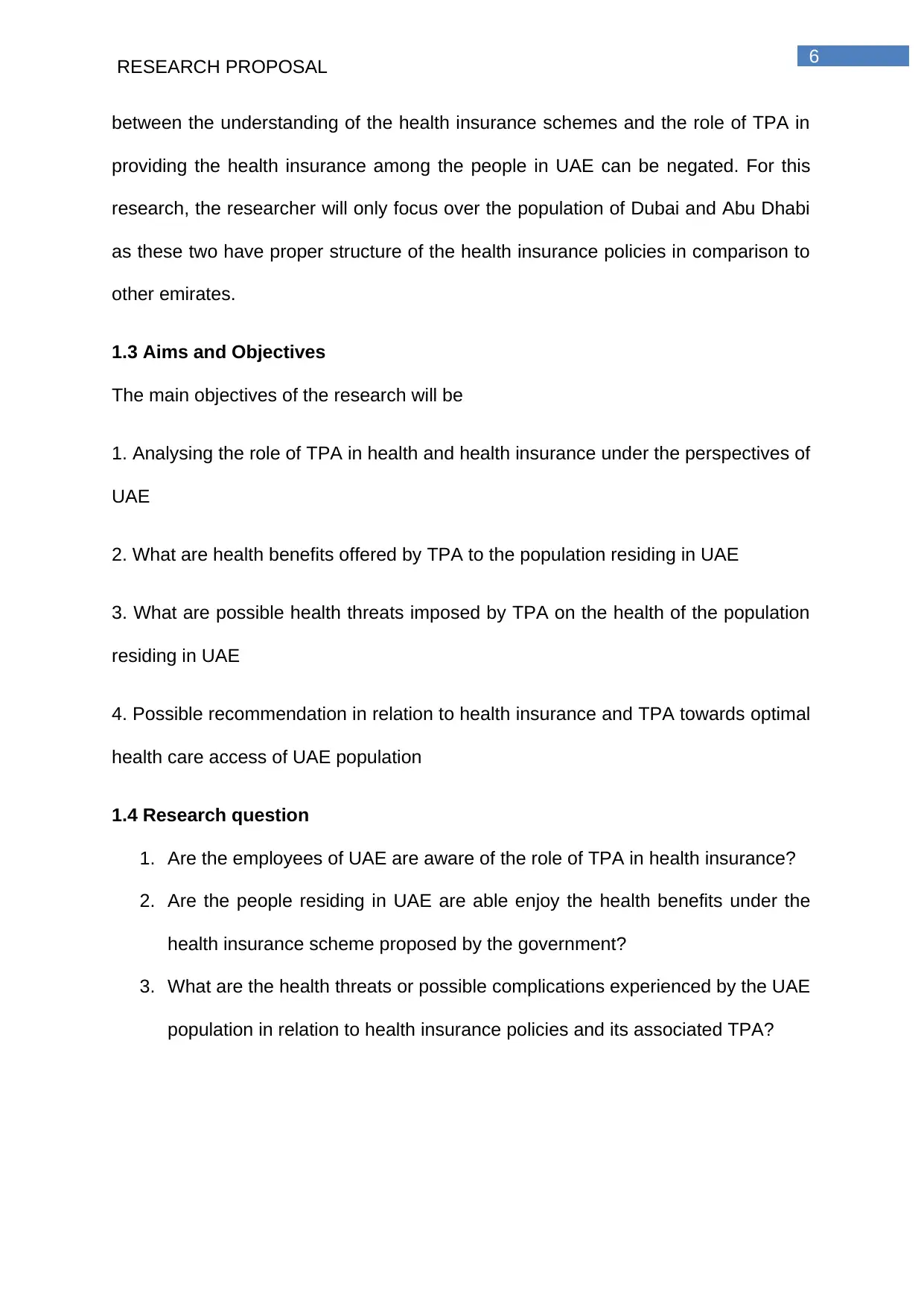
6
RESEARCH PROPOSAL
between the understanding of the health insurance schemes and the role of TPA in
providing the health insurance among the people in UAE can be negated. For this
research, the researcher will only focus over the population of Dubai and Abu Dhabi
as these two have proper structure of the health insurance policies in comparison to
other emirates.
1.3 Aims and Objectives
The main objectives of the research will be
1. Analysing the role of TPA in health and health insurance under the perspectives of
UAE
2. What are health benefits offered by TPA to the population residing in UAE
3. What are possible health threats imposed by TPA on the health of the population
residing in UAE
4. Possible recommendation in relation to health insurance and TPA towards optimal
health care access of UAE population
1.4 Research question
1. Are the employees of UAE are aware of the role of TPA in health insurance?
2. Are the people residing in UAE are able enjoy the health benefits under the
health insurance scheme proposed by the government?
3. What are the health threats or possible complications experienced by the UAE
population in relation to health insurance policies and its associated TPA?
RESEARCH PROPOSAL
between the understanding of the health insurance schemes and the role of TPA in
providing the health insurance among the people in UAE can be negated. For this
research, the researcher will only focus over the population of Dubai and Abu Dhabi
as these two have proper structure of the health insurance policies in comparison to
other emirates.
1.3 Aims and Objectives
The main objectives of the research will be
1. Analysing the role of TPA in health and health insurance under the perspectives of
UAE
2. What are health benefits offered by TPA to the population residing in UAE
3. What are possible health threats imposed by TPA on the health of the population
residing in UAE
4. Possible recommendation in relation to health insurance and TPA towards optimal
health care access of UAE population
1.4 Research question
1. Are the employees of UAE are aware of the role of TPA in health insurance?
2. Are the people residing in UAE are able enjoy the health benefits under the
health insurance scheme proposed by the government?
3. What are the health threats or possible complications experienced by the UAE
population in relation to health insurance policies and its associated TPA?
Paraphrase This Document
Need a fresh take? Get an instant paraphrase of this document with our AI Paraphraser
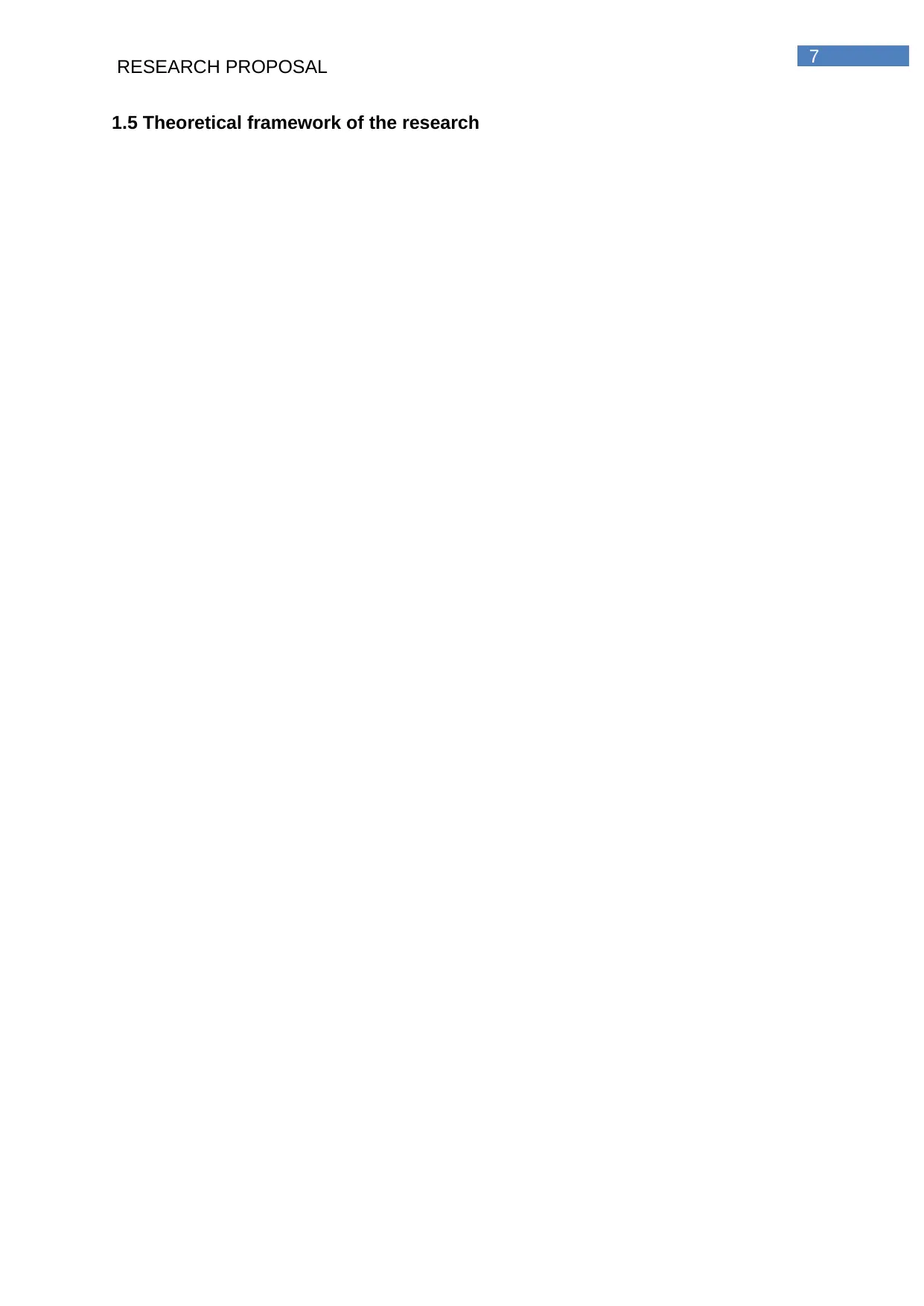
7
RESEARCH PROPOSAL
1.5 Theoretical framework of the research
RESEARCH PROPOSAL
1.5 Theoretical framework of the research
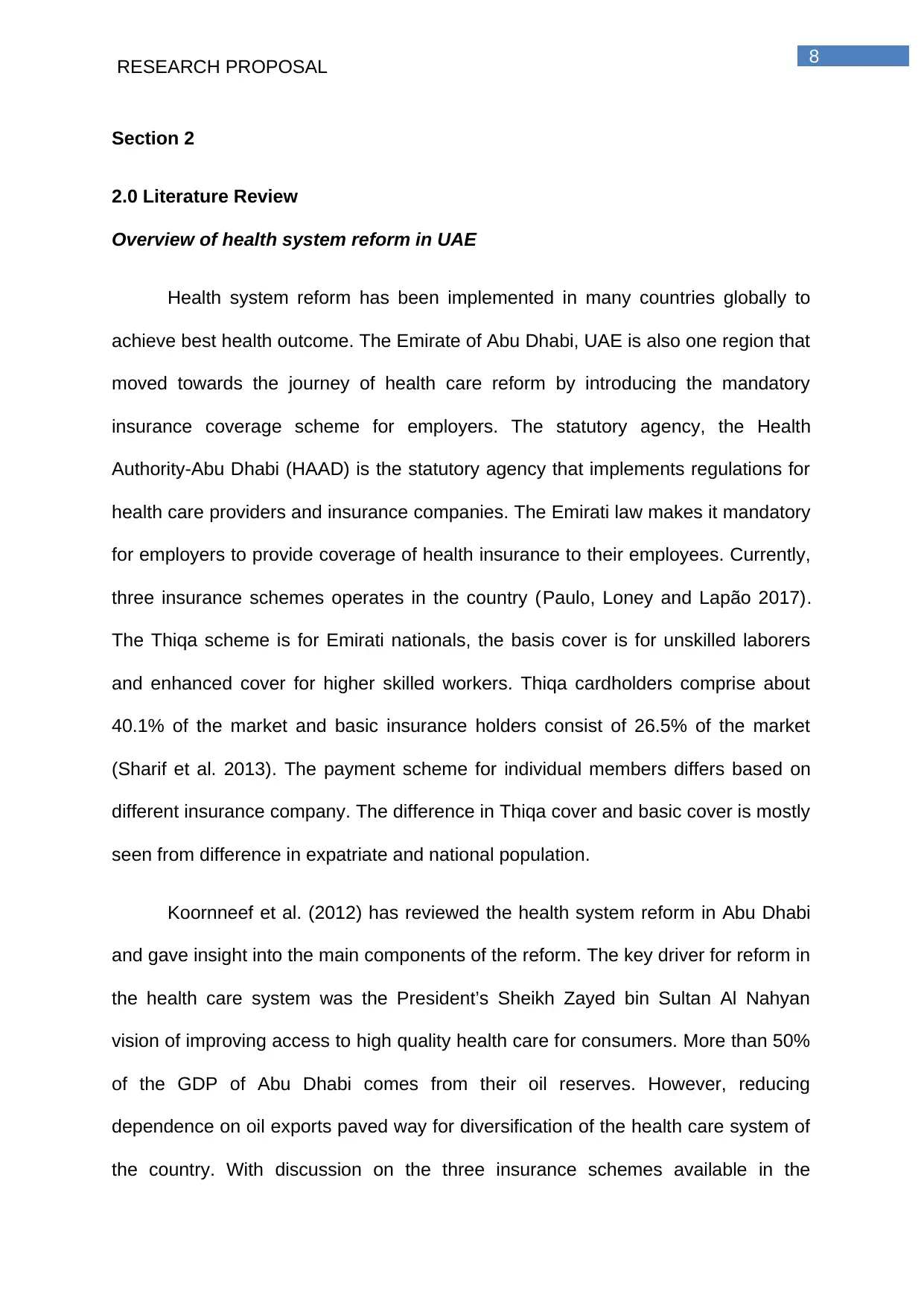
8
RESEARCH PROPOSAL
Section 2
2.0 Literature Review
Overview of health system reform in UAE
Health system reform has been implemented in many countries globally to
achieve best health outcome. The Emirate of Abu Dhabi, UAE is also one region that
moved towards the journey of health care reform by introducing the mandatory
insurance coverage scheme for employers. The statutory agency, the Health
Authority-Abu Dhabi (HAAD) is the statutory agency that implements regulations for
health care providers and insurance companies. The Emirati law makes it mandatory
for employers to provide coverage of health insurance to their employees. Currently,
three insurance schemes operates in the country (Paulo, Loney and Lapão 2017).
The Thiqa scheme is for Emirati nationals, the basis cover is for unskilled laborers
and enhanced cover for higher skilled workers. Thiqa cardholders comprise about
40.1% of the market and basic insurance holders consist of 26.5% of the market
(Sharif et al. 2013). The payment scheme for individual members differs based on
different insurance company. The difference in Thiqa cover and basic cover is mostly
seen from difference in expatriate and national population.
Koornneef et al. (2012) has reviewed the health system reform in Abu Dhabi
and gave insight into the main components of the reform. The key driver for reform in
the health care system was the President’s Sheikh Zayed bin Sultan Al Nahyan
vision of improving access to high quality health care for consumers. More than 50%
of the GDP of Abu Dhabi comes from their oil reserves. However, reducing
dependence on oil exports paved way for diversification of the health care system of
the country. With discussion on the three insurance schemes available in the
RESEARCH PROPOSAL
Section 2
2.0 Literature Review
Overview of health system reform in UAE
Health system reform has been implemented in many countries globally to
achieve best health outcome. The Emirate of Abu Dhabi, UAE is also one region that
moved towards the journey of health care reform by introducing the mandatory
insurance coverage scheme for employers. The statutory agency, the Health
Authority-Abu Dhabi (HAAD) is the statutory agency that implements regulations for
health care providers and insurance companies. The Emirati law makes it mandatory
for employers to provide coverage of health insurance to their employees. Currently,
three insurance schemes operates in the country (Paulo, Loney and Lapão 2017).
The Thiqa scheme is for Emirati nationals, the basis cover is for unskilled laborers
and enhanced cover for higher skilled workers. Thiqa cardholders comprise about
40.1% of the market and basic insurance holders consist of 26.5% of the market
(Sharif et al. 2013). The payment scheme for individual members differs based on
different insurance company. The difference in Thiqa cover and basic cover is mostly
seen from difference in expatriate and national population.
Koornneef et al. (2012) has reviewed the health system reform in Abu Dhabi
and gave insight into the main components of the reform. The key driver for reform in
the health care system was the President’s Sheikh Zayed bin Sultan Al Nahyan
vision of improving access to high quality health care for consumers. More than 50%
of the GDP of Abu Dhabi comes from their oil reserves. However, reducing
dependence on oil exports paved way for diversification of the health care system of
the country. With discussion on the three insurance schemes available in the
⊘ This is a preview!⊘
Do you want full access?
Subscribe today to unlock all pages.

Trusted by 1+ million students worldwide
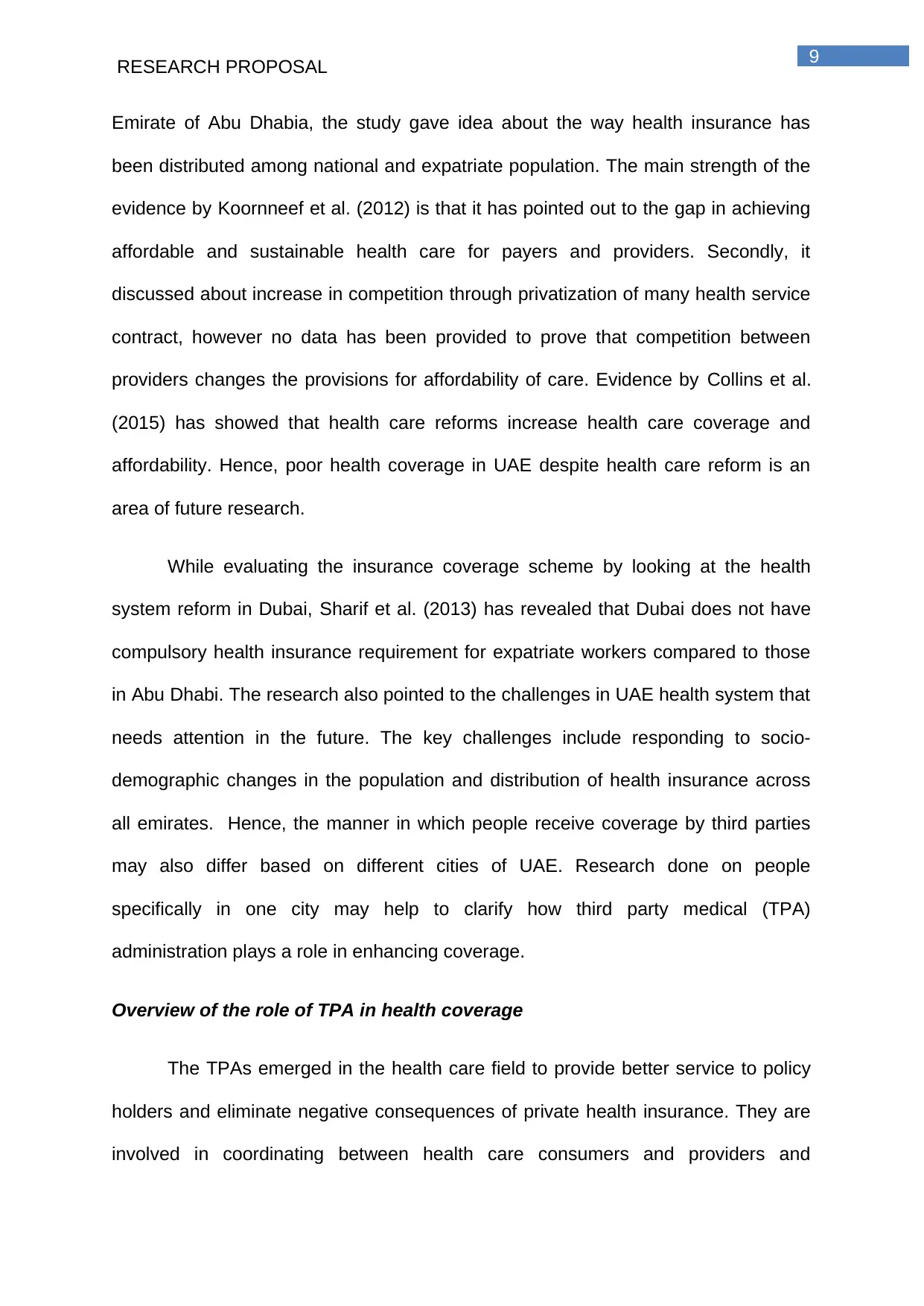
9
RESEARCH PROPOSAL
Emirate of Abu Dhabia, the study gave idea about the way health insurance has
been distributed among national and expatriate population. The main strength of the
evidence by Koornneef et al. (2012) is that it has pointed out to the gap in achieving
affordable and sustainable health care for payers and providers. Secondly, it
discussed about increase in competition through privatization of many health service
contract, however no data has been provided to prove that competition between
providers changes the provisions for affordability of care. Evidence by Collins et al.
(2015) has showed that health care reforms increase health care coverage and
affordability. Hence, poor health coverage in UAE despite health care reform is an
area of future research.
While evaluating the insurance coverage scheme by looking at the health
system reform in Dubai, Sharif et al. (2013) has revealed that Dubai does not have
compulsory health insurance requirement for expatriate workers compared to those
in Abu Dhabi. The research also pointed to the challenges in UAE health system that
needs attention in the future. The key challenges include responding to socio-
demographic changes in the population and distribution of health insurance across
all emirates. Hence, the manner in which people receive coverage by third parties
may also differ based on different cities of UAE. Research done on people
specifically in one city may help to clarify how third party medical (TPA)
administration plays a role in enhancing coverage.
Overview of the role of TPA in health coverage
The TPAs emerged in the health care field to provide better service to policy
holders and eliminate negative consequences of private health insurance. They are
involved in coordinating between health care consumers and providers and
RESEARCH PROPOSAL
Emirate of Abu Dhabia, the study gave idea about the way health insurance has
been distributed among national and expatriate population. The main strength of the
evidence by Koornneef et al. (2012) is that it has pointed out to the gap in achieving
affordable and sustainable health care for payers and providers. Secondly, it
discussed about increase in competition through privatization of many health service
contract, however no data has been provided to prove that competition between
providers changes the provisions for affordability of care. Evidence by Collins et al.
(2015) has showed that health care reforms increase health care coverage and
affordability. Hence, poor health coverage in UAE despite health care reform is an
area of future research.
While evaluating the insurance coverage scheme by looking at the health
system reform in Dubai, Sharif et al. (2013) has revealed that Dubai does not have
compulsory health insurance requirement for expatriate workers compared to those
in Abu Dhabi. The research also pointed to the challenges in UAE health system that
needs attention in the future. The key challenges include responding to socio-
demographic changes in the population and distribution of health insurance across
all emirates. Hence, the manner in which people receive coverage by third parties
may also differ based on different cities of UAE. Research done on people
specifically in one city may help to clarify how third party medical (TPA)
administration plays a role in enhancing coverage.
Overview of the role of TPA in health coverage
The TPAs emerged in the health care field to provide better service to policy
holders and eliminate negative consequences of private health insurance. They are
involved in coordinating between health care consumers and providers and
Paraphrase This Document
Need a fresh take? Get an instant paraphrase of this document with our AI Paraphraser

10
RESEARCH PROPOSAL
monitoring uses of services and resources (Kennedy and Bartlett 2014). The study
Hamidi and Akinci (2015) mainly focused on evaluating health care payment reforms
in Abu Dhabi. The mandatory health insurance system resulted in the introduction of
many payment reforms in Abu Dhabi. HAAD has been mainly involved in regulating
health care across UAE. Individuals, employers and government are the three main
sources of financing in the city. The author explained that apart from for-profits
insurance companies and brokers, 13 TPAs are also involves in operating health
insurance scheme. Many regional companies like Oman Insurance and Green
Crescent are large payers and small payers outsource administration to TPAs. The
significance of the Hamidi and Akinci (2015) study is that it gave idea about the
impact of these reforms of health care consumers and providers. The positive side of
health reform implementation was that it resulted in rise in demand for medical
service among expatriates. Expatriates workers got the advantage of letting go off
out-of-pocket payments. However, to address the issue of environment sustainability
in the future, there was a need for more research to critically examine the impact of
TPAs in harmonizing payment system and promoting transparency in hospital
financing. This is necessary because Hoo and Lansky (2016) has argued that health
care cost mainly remain unsustainable and applying principles of incentive alignment
may help to fulfill shared goals.
Although there are very few research which has examined the role of TPAs
particularly in UAE, however research evidence has given insight into potential role
of TPAs in health care system of UAE in the future. Alshamsan et al. (2017) aimed to
evaluate percentage of individuals who borrowed for medical reasons and those
people who failed to get adequate funds in Gulf states. This research was
importance in an effort to realize the goals of universal health coverage and
RESEARCH PROPOSAL
monitoring uses of services and resources (Kennedy and Bartlett 2014). The study
Hamidi and Akinci (2015) mainly focused on evaluating health care payment reforms
in Abu Dhabi. The mandatory health insurance system resulted in the introduction of
many payment reforms in Abu Dhabi. HAAD has been mainly involved in regulating
health care across UAE. Individuals, employers and government are the three main
sources of financing in the city. The author explained that apart from for-profits
insurance companies and brokers, 13 TPAs are also involves in operating health
insurance scheme. Many regional companies like Oman Insurance and Green
Crescent are large payers and small payers outsource administration to TPAs. The
significance of the Hamidi and Akinci (2015) study is that it gave idea about the
impact of these reforms of health care consumers and providers. The positive side of
health reform implementation was that it resulted in rise in demand for medical
service among expatriates. Expatriates workers got the advantage of letting go off
out-of-pocket payments. However, to address the issue of environment sustainability
in the future, there was a need for more research to critically examine the impact of
TPAs in harmonizing payment system and promoting transparency in hospital
financing. This is necessary because Hoo and Lansky (2016) has argued that health
care cost mainly remain unsustainable and applying principles of incentive alignment
may help to fulfill shared goals.
Although there are very few research which has examined the role of TPAs
particularly in UAE, however research evidence has given insight into potential role
of TPAs in health care system of UAE in the future. Alshamsan et al. (2017) aimed to
evaluate percentage of individuals who borrowed for medical reasons and those
people who failed to get adequate funds in Gulf states. This research was
importance in an effort to realize the goals of universal health coverage and
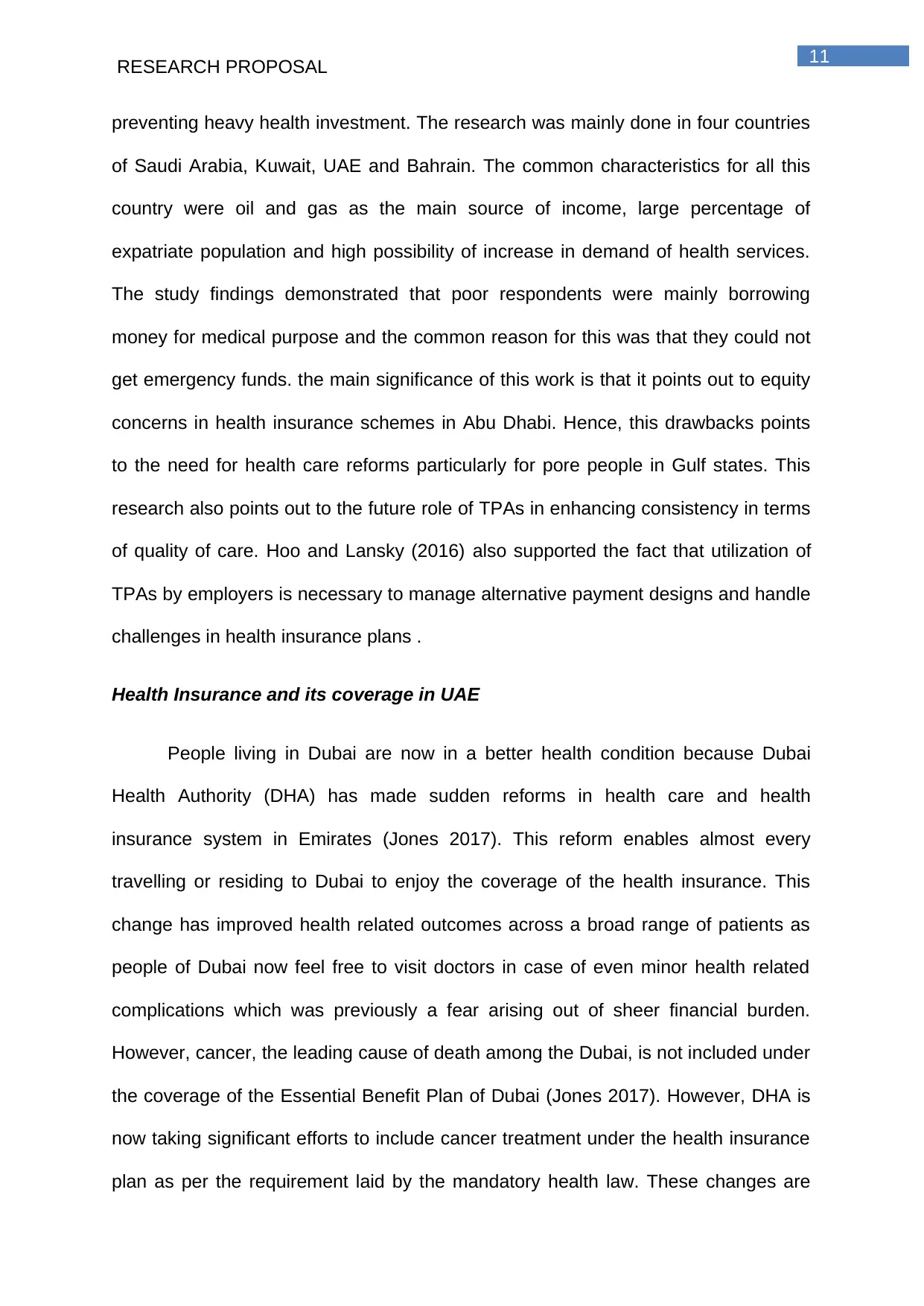
11
RESEARCH PROPOSAL
preventing heavy health investment. The research was mainly done in four countries
of Saudi Arabia, Kuwait, UAE and Bahrain. The common characteristics for all this
country were oil and gas as the main source of income, large percentage of
expatriate population and high possibility of increase in demand of health services.
The study findings demonstrated that poor respondents were mainly borrowing
money for medical purpose and the common reason for this was that they could not
get emergency funds. the main significance of this work is that it points out to equity
concerns in health insurance schemes in Abu Dhabi. Hence, this drawbacks points
to the need for health care reforms particularly for pore people in Gulf states. This
research also points out to the future role of TPAs in enhancing consistency in terms
of quality of care. Hoo and Lansky (2016) also supported the fact that utilization of
TPAs by employers is necessary to manage alternative payment designs and handle
challenges in health insurance plans .
Health Insurance and its coverage in UAE
People living in Dubai are now in a better health condition because Dubai
Health Authority (DHA) has made sudden reforms in health care and health
insurance system in Emirates (Jones 2017). This reform enables almost every
travelling or residing to Dubai to enjoy the coverage of the health insurance. This
change has improved health related outcomes across a broad range of patients as
people of Dubai now feel free to visit doctors in case of even minor health related
complications which was previously a fear arising out of sheer financial burden.
However, cancer, the leading cause of death among the Dubai, is not included under
the coverage of the Essential Benefit Plan of Dubai (Jones 2017). However, DHA is
now taking significant efforts to include cancer treatment under the health insurance
plan as per the requirement laid by the mandatory health law. These changes are
RESEARCH PROPOSAL
preventing heavy health investment. The research was mainly done in four countries
of Saudi Arabia, Kuwait, UAE and Bahrain. The common characteristics for all this
country were oil and gas as the main source of income, large percentage of
expatriate population and high possibility of increase in demand of health services.
The study findings demonstrated that poor respondents were mainly borrowing
money for medical purpose and the common reason for this was that they could not
get emergency funds. the main significance of this work is that it points out to equity
concerns in health insurance schemes in Abu Dhabi. Hence, this drawbacks points
to the need for health care reforms particularly for pore people in Gulf states. This
research also points out to the future role of TPAs in enhancing consistency in terms
of quality of care. Hoo and Lansky (2016) also supported the fact that utilization of
TPAs by employers is necessary to manage alternative payment designs and handle
challenges in health insurance plans .
Health Insurance and its coverage in UAE
People living in Dubai are now in a better health condition because Dubai
Health Authority (DHA) has made sudden reforms in health care and health
insurance system in Emirates (Jones 2017). This reform enables almost every
travelling or residing to Dubai to enjoy the coverage of the health insurance. This
change has improved health related outcomes across a broad range of patients as
people of Dubai now feel free to visit doctors in case of even minor health related
complications which was previously a fear arising out of sheer financial burden.
However, cancer, the leading cause of death among the Dubai, is not included under
the coverage of the Essential Benefit Plan of Dubai (Jones 2017). However, DHA is
now taking significant efforts to include cancer treatment under the health insurance
plan as per the requirement laid by the mandatory health law. These changes are
⊘ This is a preview!⊘
Do you want full access?
Subscribe today to unlock all pages.

Trusted by 1+ million students worldwide
1 out of 24
Your All-in-One AI-Powered Toolkit for Academic Success.
+13062052269
info@desklib.com
Available 24*7 on WhatsApp / Email
![[object Object]](/_next/static/media/star-bottom.7253800d.svg)
Unlock your academic potential
Copyright © 2020–2025 A2Z Services. All Rights Reserved. Developed and managed by ZUCOL.